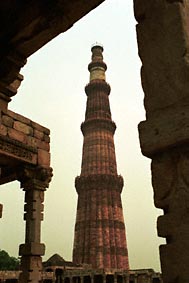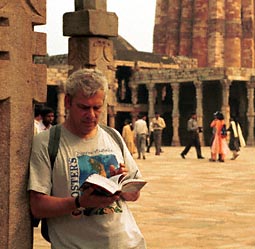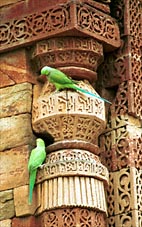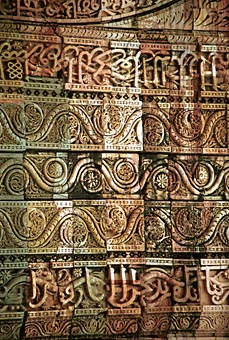 The next day we went to buy train tickets. As soon as we left our
hotel we were invited by a friendly smiling Indian to take a ride in his autoriksja. He
looked vaguely familiar (but for us all Indians look a bit the same I'm afraid...) and
indeed, it happened to be the same man that took us to the Red Fort yesterday and tried to take us
to the Jama Masjid! I remembered
now that we told him the name of the hotel where we stayed. According to our LP travel
guide Indians always want to know everything,
The next day we went to buy train tickets. As soon as we left our
hotel we were invited by a friendly smiling Indian to take a ride in his autoriksja. He
looked vaguely familiar (but for us all Indians look a bit the same I'm afraid...) and
indeed, it happened to be the same man that took us to the Red Fort yesterday and tried to take us
to the Jama Masjid! I remembered
now that we told him the name of the hotel where we stayed. According to our LP travel
guide Indians always want to know everything,  but sometimes this is not only pure
curiosity! So we took a ride to the train station and after reserving our train tickets
(which took only 1 hour, much less than we apprehended), we sneaky left the train station
on the opposite side and took a 'pre-paid taxi' (you still have to pay, but much less than
when you do the bargaining yourself!) to the Qutab Minar complex.
but sometimes this is not only pure
curiosity! So we took a ride to the train station and after reserving our train tickets
(which took only 1 hour, much less than we apprehended), we sneaky left the train station
on the opposite side and took a 'pre-paid taxi' (you still have to pay, but much less than
when you do the bargaining yourself!) to the Qutab Minar complex.
 The
Qutab Minar complex, south of Delhi, is much older than the Red Fort and the Jama Mashid.
Jac is reading in our LP bible for some details. The complex dates from around 1200, the
onset of Muslim rule in India. The complex is named after the 73-meter high tower; a tower
of victory that was started after Qutab-ud-din Abak defeated the last Hindu kingdoms. The
tower is slightly tilted, a bit like the tower of Pisa in Italy. The buildings are made
from red sandstone and white marble, and are really beautifully decorated, mostly with
inscriptions from the Koran. The mosque, Quwatul-ul-Islam Masjid, the first mosque of
India, was built of the remains from the destroyed Hindu and Jain temples. Except for
tourists, again mainly Indian, the complex was also very interesting for a lot of
parakeets, who tried to read the inscriptions from quite close-by!
The
Qutab Minar complex, south of Delhi, is much older than the Red Fort and the Jama Mashid.
Jac is reading in our LP bible for some details. The complex dates from around 1200, the
onset of Muslim rule in India. The complex is named after the 73-meter high tower; a tower
of victory that was started after Qutab-ud-din Abak defeated the last Hindu kingdoms. The
tower is slightly tilted, a bit like the tower of Pisa in Italy. The buildings are made
from red sandstone and white marble, and are really beautifully decorated, mostly with
inscriptions from the Koran. The mosque, Quwatul-ul-Islam Masjid, the first mosque of
India, was built of the remains from the destroyed Hindu and Jain temples. Except for
tourists, again mainly Indian, the complex was also very interesting for a lot of
parakeets, who tried to read the inscriptions from quite close-by!
 At the end of the day we visited the Jantar Mantar in
New Delhi, close to Connaught Place. The Jantar Mantar is a group of pink painted
astronomic instruments, looking more like modern artwork than like scientific devices
dating from the 17th century! Maharaja Jai Singh II builds this observatory in 1725. This
Maharaja built also observatories in Jaipur and Varanasi. The buildings in Jaipur are
quite well preserved, see the Jaipur pages
for pictures. Afterwards we went to eat on Connaught Place. The restaurant was very
expensive for Indian standards and they even served red wine, quite extraordinary for the
Hindu India. I think we really enjoyed the wine, because we seem to have circled Connaught
Place twice before taking the right turn! We blamed the begging children, who haunted us
all along our two turns.
At the end of the day we visited the Jantar Mantar in
New Delhi, close to Connaught Place. The Jantar Mantar is a group of pink painted
astronomic instruments, looking more like modern artwork than like scientific devices
dating from the 17th century! Maharaja Jai Singh II builds this observatory in 1725. This
Maharaja built also observatories in Jaipur and Varanasi. The buildings in Jaipur are
quite well preserved, see the Jaipur pages
for pictures. Afterwards we went to eat on Connaught Place. The restaurant was very
expensive for Indian standards and they even served red wine, quite extraordinary for the
Hindu India. I think we really enjoyed the wine, because we seem to have circled Connaught
Place twice before taking the right turn! We blamed the begging children, who haunted us
all along our two turns.
We  see a lot of people sleeping on the street,
just like the sacred cows! People aren’t worth anything here, you just have to manage
by yourself, nobody else will help you. But people who live on the street still have their
dignity: sometimes they make a kind of open tent to sleep under, they built a small fire
to cook something and brush
there teeth as soon as they wake up! I have respect for people who go on brushing
their teeth when everything else stops; it is a kind of clinging to sanity which touches
the heart. I worry about the cold in the winters, even in India it can be cold. But the
riksja drivers tell me that temperatures below zero are no problem for people living on
the street, it are the very high (above 40 degrees Celsius) temperatures in summer that
make victims. A riksja driver further explains this while making impressive movements with
his arms: 'This is because you can put on clothes to stay warm, but when it is that hot
there is nothing you can do.'.
see a lot of people sleeping on the street,
just like the sacred cows! People aren’t worth anything here, you just have to manage
by yourself, nobody else will help you. But people who live on the street still have their
dignity: sometimes they make a kind of open tent to sleep under, they built a small fire
to cook something and brush
there teeth as soon as they wake up! I have respect for people who go on brushing
their teeth when everything else stops; it is a kind of clinging to sanity which touches
the heart. I worry about the cold in the winters, even in India it can be cold. But the
riksja drivers tell me that temperatures below zero are no problem for people living on
the street, it are the very high (above 40 degrees Celsius) temperatures in summer that
make victims. A riksja driver further explains this while making impressive movements with
his arms: 'This is because you can put on clothes to stay warm, but when it is that hot
there is nothing you can do.'.
 The next day we went to buy train tickets. As soon as we left our
hotel we were invited by a friendly smiling Indian to take a ride in his autoriksja. He
looked vaguely familiar (but for us all Indians look a bit the same I'm afraid...) and
indeed, it happened to be the same man that took us to the Red Fort yesterday and tried to take us
to the Jama Masjid! I remembered
now that we told him the name of the hotel where we stayed. According to our LP travel
guide Indians always want to know everything,
The next day we went to buy train tickets. As soon as we left our
hotel we were invited by a friendly smiling Indian to take a ride in his autoriksja. He
looked vaguely familiar (but for us all Indians look a bit the same I'm afraid...) and
indeed, it happened to be the same man that took us to the Red Fort yesterday and tried to take us
to the Jama Masjid! I remembered
now that we told him the name of the hotel where we stayed. According to our LP travel
guide Indians always want to know everything,  but sometimes this is not only pure
curiosity! So we took a ride to the train station and after reserving our train tickets
(which took only 1 hour, much less than we apprehended), we sneaky left the train station
on the opposite side and took a 'pre-paid taxi' (you still have to pay, but much less than
when you do the bargaining yourself!) to the Qutab Minar complex.
but sometimes this is not only pure
curiosity! So we took a ride to the train station and after reserving our train tickets
(which took only 1 hour, much less than we apprehended), we sneaky left the train station
on the opposite side and took a 'pre-paid taxi' (you still have to pay, but much less than
when you do the bargaining yourself!) to the Qutab Minar complex. The
Qutab Minar complex, south of Delhi, is much older than the Red Fort and the Jama Mashid.
Jac is reading in our LP bible for some details. The complex dates from around 1200, the
onset of Muslim rule in India. The complex is named after the 73-meter high tower; a tower
of victory that was started after Qutab-ud-din Abak defeated the last Hindu kingdoms. The
tower is slightly tilted, a bit like the tower of Pisa in Italy. The buildings are made
from red sandstone and white marble, and are really beautifully decorated, mostly with
inscriptions from the Koran. The mosque, Quwatul-ul-Islam Masjid, the first mosque of
India, was built of the remains from the destroyed Hindu and Jain temples. Except for
tourists, again mainly Indian, the complex was also very interesting for a lot of
parakeets, who tried to read the inscriptions from quite close-by!
The
Qutab Minar complex, south of Delhi, is much older than the Red Fort and the Jama Mashid.
Jac is reading in our LP bible for some details. The complex dates from around 1200, the
onset of Muslim rule in India. The complex is named after the 73-meter high tower; a tower
of victory that was started after Qutab-ud-din Abak defeated the last Hindu kingdoms. The
tower is slightly tilted, a bit like the tower of Pisa in Italy. The buildings are made
from red sandstone and white marble, and are really beautifully decorated, mostly with
inscriptions from the Koran. The mosque, Quwatul-ul-Islam Masjid, the first mosque of
India, was built of the remains from the destroyed Hindu and Jain temples. Except for
tourists, again mainly Indian, the complex was also very interesting for a lot of
parakeets, who tried to read the inscriptions from quite close-by! At the end of the day we visited the Jantar Mantar in
New Delhi, close to Connaught Place. The Jantar Mantar is a group of pink painted
astronomic instruments, looking more like modern artwork than like scientific devices
dating from the 17th century! Maharaja Jai Singh II builds this observatory in 1725. This
Maharaja built also observatories in Jaipur and Varanasi. The buildings in Jaipur are
quite well preserved, see the
At the end of the day we visited the Jantar Mantar in
New Delhi, close to Connaught Place. The Jantar Mantar is a group of pink painted
astronomic instruments, looking more like modern artwork than like scientific devices
dating from the 17th century! Maharaja Jai Singh II builds this observatory in 1725. This
Maharaja built also observatories in Jaipur and Varanasi. The buildings in Jaipur are
quite well preserved, see the  see a lot of people sleeping on the street,
just like the sacred cows! People aren’t worth anything here, you just have to manage
by yourself, nobody else will help you. But people who live on the street still have their
dignity: sometimes they make a kind of open tent to sleep under, they built a small fire
to cook something and
see a lot of people sleeping on the street,
just like the sacred cows! People aren’t worth anything here, you just have to manage
by yourself, nobody else will help you. But people who live on the street still have their
dignity: sometimes they make a kind of open tent to sleep under, they built a small fire
to cook something and 




